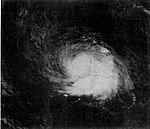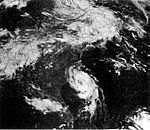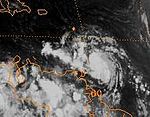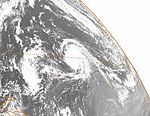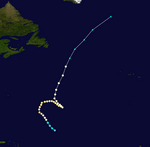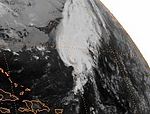Quick facts for kids
1986 Atlantic hurricane season
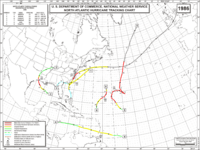 |
| First storm started: |
June 5, 1986 |
| Last storm ended: |
November 21, 1986 |
| Strongest storm: |
Hurricane Earl - 978 mbar, 105 mph winds |
| Total storms: |
6 |
| Hurricanes: |
4 |
| Major hurricanes (Cat. 3+) |
0 |
| Cost of damage: |
$3 billion (1986 USD)
$5.2 billion (2005 USD) |
| People killed: |
9 direct |
|
The 1986 Atlantic hurricane season officially started on June 1, 1983, and ended on November 30. The season had a total of 6 named storms and 4 hurricanes.
Storms
Tropical Storm Andrew
| Tropical storm (SSHS) |
|
|
| Duration |
June 5 – June 8 |
| Intensity |
50 mph (85 km/h) (1-min), 999 mbar (hPa) |
Tropical Depression One formed on June 5 north of the Bahamas. It strengthened into Tropical Storm Andrew the next day. Andrew traveled along the East Coast of the United States, creating giant waves and high surf along the shore but with minor damages. Andrew dissipated south of Cape Cod. One person drowned off the North Carolina coast in high surf, but no major damages was reported.
Hurricane Bonnie
| Category 1 hurricane (SSHS) |
|
|
| Duration |
June 23 – June 28 |
| Intensity |
85 mph (140 km/h) (1-min), 990 mbar (hPa) |
Tropical Depression Two formed south of the Louisiana coast on June 23 and quickly strengthened into a hurricane. Bonnie made landfall on the upper Texas coast near High Island. Streets were flooded throughout southeast Texas, mobile homes were destroyed, and three people were killed. Bonnie caused $2 million (1986 USD) in damage.
Hurricane Charley
| Category 1 hurricane (SSHS) |
|
|
| Duration |
August 13 – August 18 |
| Intensity |
80 mph (130 km/h) (1-min), 987 mbar (hPa) |
A tropical depression formed off the coast of the Florida and moved inland. The depression then travelled across Florida and exited the coast near Savannah, Georgia, and strengthened into Tropical Storm Charley. Charley continued moving up the coastline, and the storm strengthened into a hurricane before moving across the Outer Banks and Delmarva Peninsula. Charley then moved out into the sea, later became extratropical in the north Atlantic Ocean, and later brought bad weather across the British Isles on August 25 where it caused major damages.
Tropical Storm Danielle
| Tropical storm (SSHS) |
|
|
| Duration |
September 7 – September 10 |
| Intensity |
60 mph (95 km/h) (1-min), 1000 mbar (hPa) |
On September 1, a tropical wave moved off the coast of Africa and moved west. The disturbance was below the 10 degree latitude as it developed into a tropical depression on September 7 and then strengthened into a tropical storm later that day. Danielle peaked as a 60 mph storm on September 8, while a Reconnaissance Aircraft reported gusts of up to hurricane force. After passing through the Lesser Antilles, Danielle came across vertical wind shear, and on September 10, it dissipated in the central Caribbean Sea. The remnants of Danielle continued to move west and eventually redeveloped in the Pacific Ocean as Tropical Storm Lester.
Hurricane Earl
| Category 2 hurricane (SSHS) |
|
|
| Duration |
September 10 – September 19 |
| Intensity |
105 mph (165 km/h) (1-min), 979 mbar (hPa) |
The strongest storm of the season began as a tropical wave off Africa on September 4. After moving across the tropical Atlantic Ocean it strengthened as Tropical Depression Five on September 10 while about 1240 miles (2000 km) east of Puerto Rico. The depression quickly strengthened and reached hurricane strength on September 11; Earl reached its strongest point on September 12, as a Category 2 hurricane as it travelled in a half circle.
The hurricane weakened to a Category 1 on September 16 and bounced back the way it came. Earl then turned north and became extratropical southeast of Newfoundland on September 19. At its strongest point, Earl had sustained winds of 105 mph (170 km/h) and a minimum central pressure of 979 mbar.
Hurricane Frances
| Category 1 hurricane (SSHS) |
|
|
| Duration |
November 18 – November 21 |
| Intensity |
85 mph (140 km/h) (1-min), 1000 mbar (hPa) |
Tropical Depression Six formed on November 18 and quickly strengthened into a tropical storm. The storm curved northeast and strengthened further, reaching hurricane strength on November 20. However, a high pressure system to the north caused the storm to fall apart. Frances was later destroyed by an extratropical low on November 21.
Storm names
These were the names set aside to be used in 1986 Atlantic hurricane. In the Atlantic, the names are used again every six years, so many of these names were used in 1980 and again in 1992. The names that did not get used are marked with gray.
- Andrew
- Bonnie
- Charley
- Danielle
- Earl
- Frances
- Georges (unused)
|
- Hermine (unused)
- Ivan (unused)
- Jeanne (unused)
- Karl (unused)
- Lisa (unused)
- Mitch (unused)
- Nicole (unused)
|
- Otto (unused)
- Paula (unused)
- Richard (unused)
- Shary (unused)
- Tomas (unused)
- Virginie (unused)
- Walter (unused)
|
Retirement
No names were retired from the 1986 Atlantic hurricane season.
Related pages
|
Tropical cyclones of the 1986 Atlantic hurricane season
|
|
|
|
|
|
See also
 In Spanish: Temporada de huracanes en el Atlántico de 1986 para niños
In Spanish: Temporada de huracanes en el Atlántico de 1986 para niños

 In Spanish: Temporada de huracanes en el Atlántico de 1986 para niños
In Spanish: Temporada de huracanes en el Atlántico de 1986 para niños



